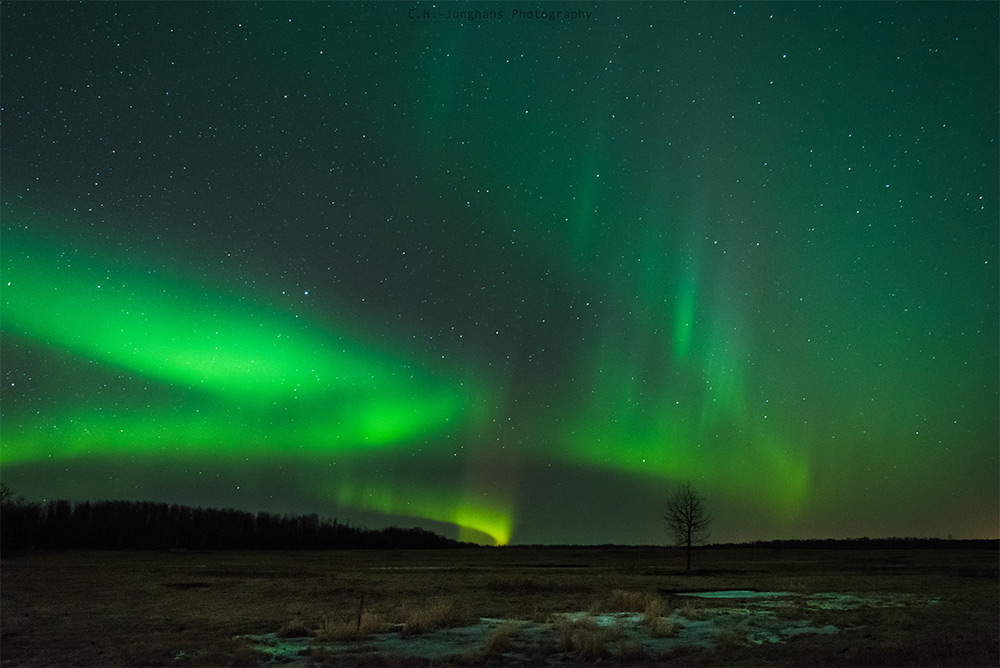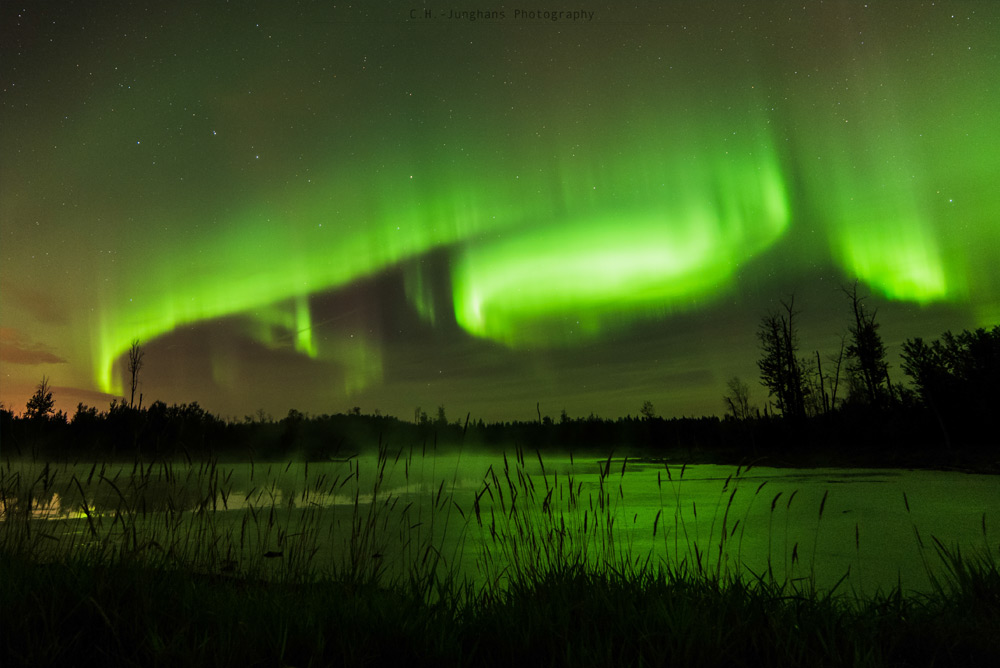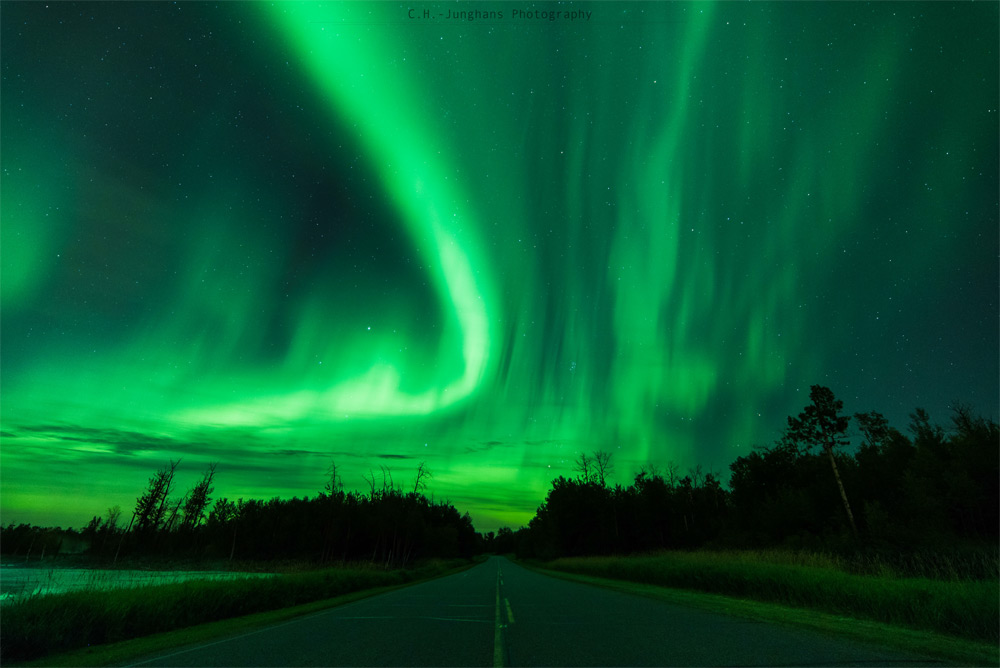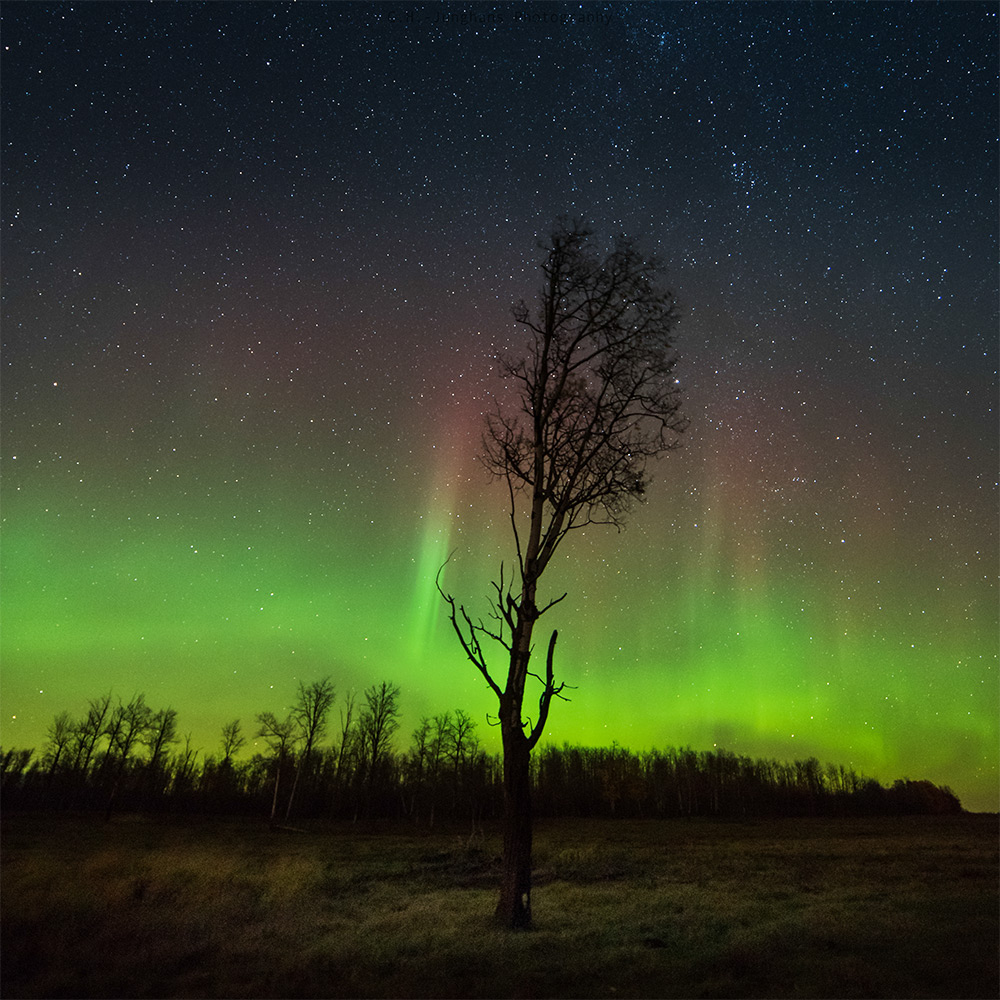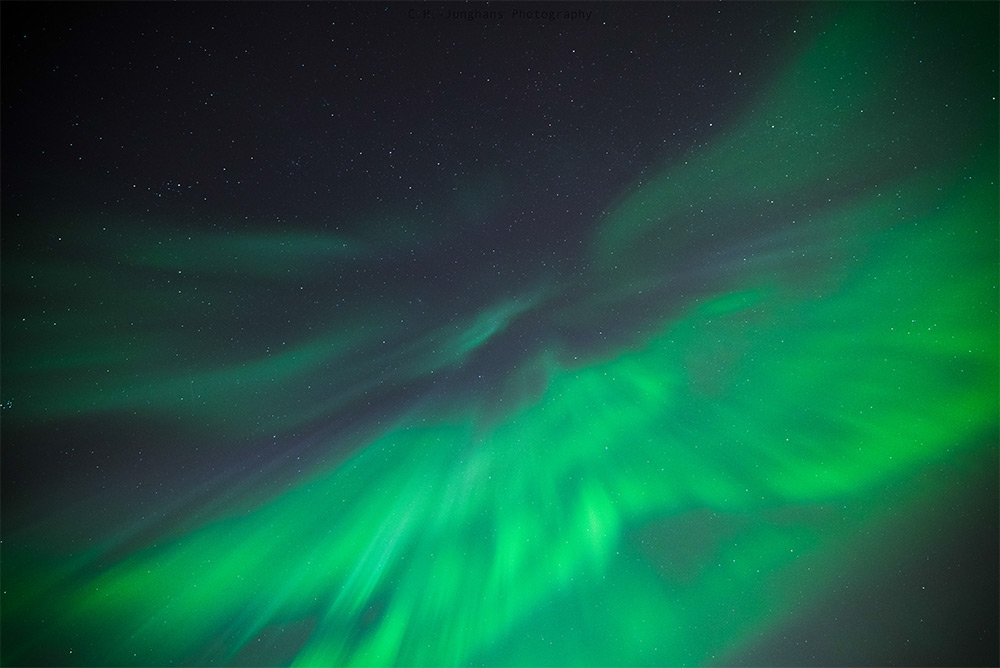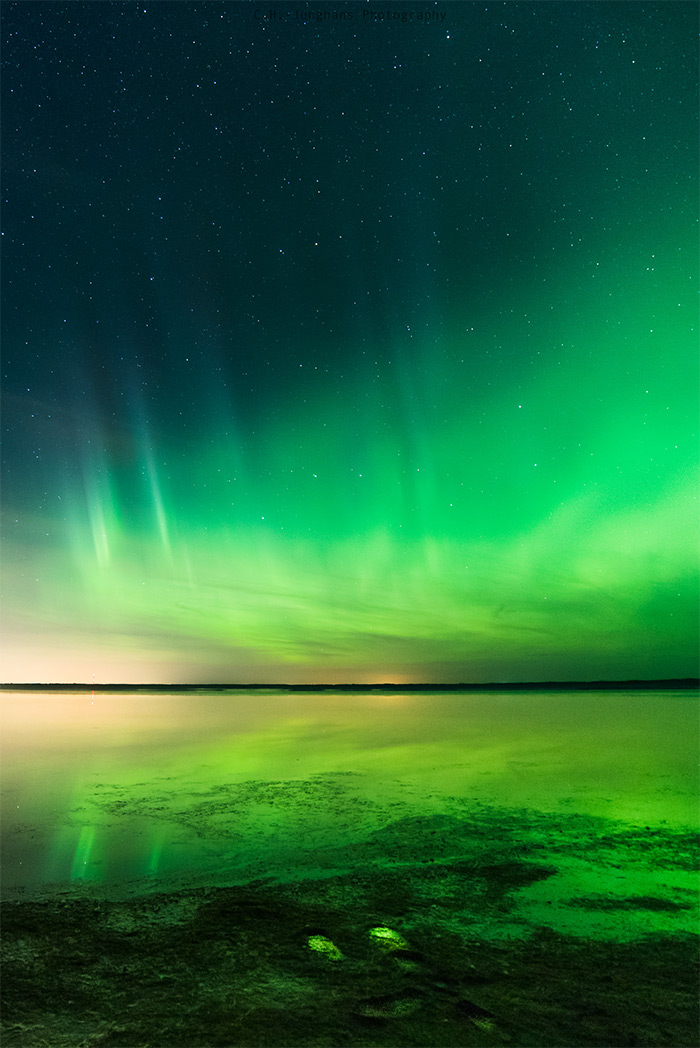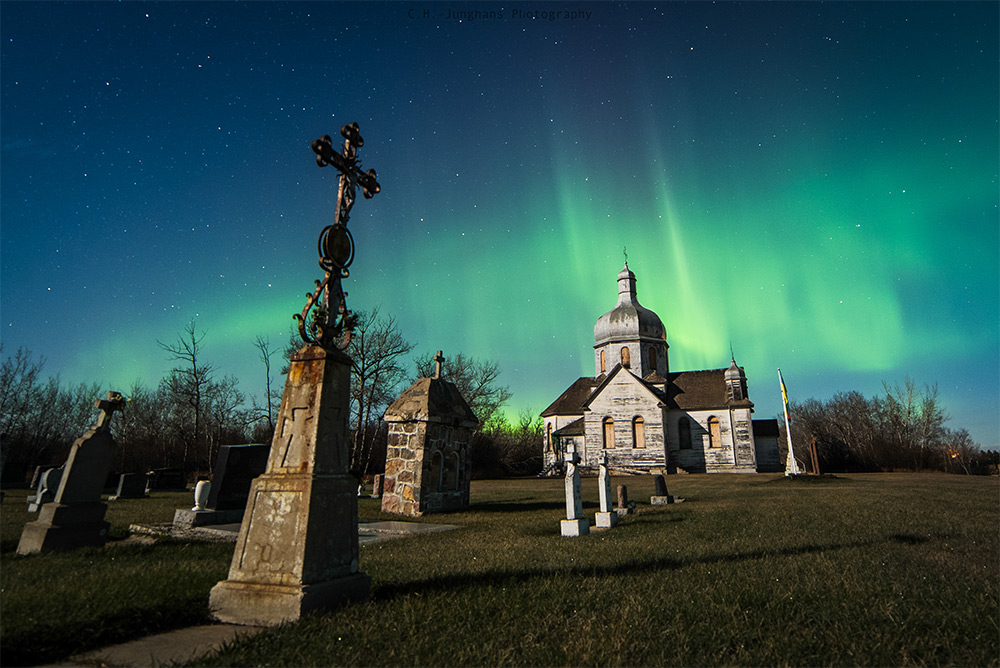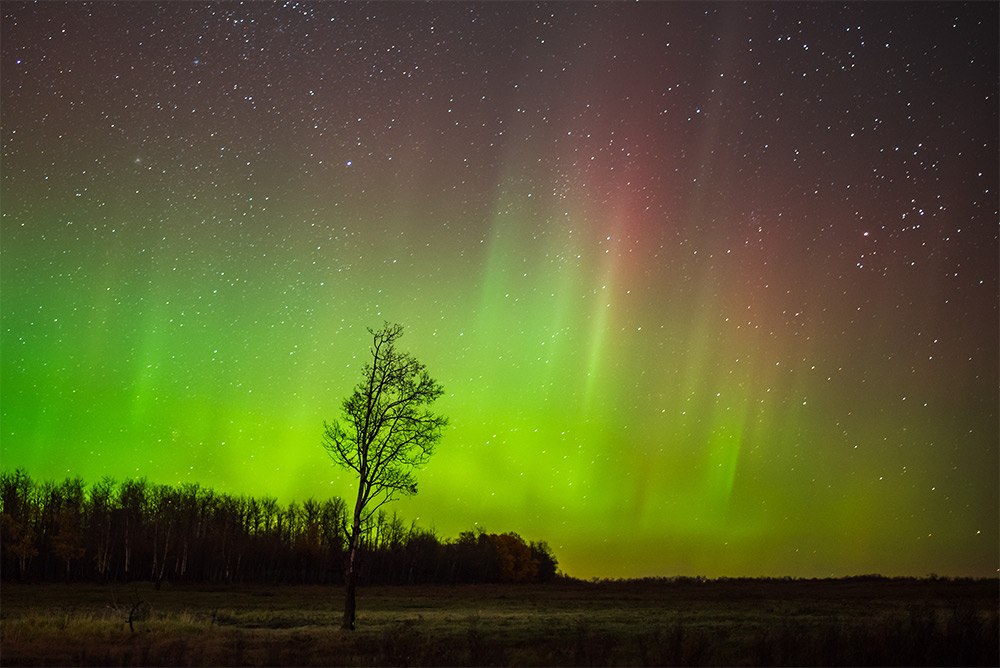When most Albertans go to sleep I am usually checking the current geomagnetic data – I am chasing the northern lights, also known as aurora borealis. Around Edmonton auroras are visible approximately 40 times a year, even more so further north. When I came to Canada I thought auroras can only be seen far north close to the polar circle. However, in Canada you can marvel at them in most parts even at minor geomagnetic storms, due to the orientation of earth magnetic field. The northern lights originate from charged particles in the solar wind interacting with molecules in the atmosphere.
St. Patrick’s Day Aurora. Taken short before midnight on March 17th in Elk Island Nationalpark. The camera was placed on the roof of my car and the tree on the field made for an interesting foreground. Nikon D750@24mm, ISO3200, f6.3, 20 sec.
I first experienced the aurora borealis in Elk Island Nationalpark east of Edmonton on St. Patricks Day 2015. On that day the strongest geomagnetic storm of this solar cycle peaked. The aurora was vibrant and simply stunning. However, I just had my Nikon D750 with the 24-85 3.5-5.6 VR kit lens and my car; no tripod and no cable release. Consequnetly, I ended up placing my camera on the roof of my car, while using my hat to adjust its orientation. I set my camera to a mirror lock-up of 3secs (to reduce vibrations), played with the settings and orientation of the camera. This night I used less than optimal parameters: ISO 3200, f6.3 and 20 sec exposure time. Nevertheless I recorded good pictures. On that night in march I got infected with the aurora virus and started reading about and understanding the phenomenon.
Misty Pond. On 12 am on August 24th a coronal hole highspeed stream arrived at earth and spurned a G3 geomagnetic storm with vibrant auroral displays. This is a small roadside pond creating an interesting foreground for this bright aurora. Nikon D750@14mm, ISO1600, f2.8, 8sec.
I purchased a tripod, a cable release and even a fast ultra wide angle lens, the Rokinon 14mm/2.8. I wanted to capture not just good but amazing pictures and here is what I learned since that first day in March.
A Drive under the Aurora. For this picture I placed the camera in the middle of the highway to capture what it is like to drive under the aurora. Nikon D750@14mm, ISO1600, f2.8, 10sec.
Take the time to find places with little light pollution (www.darksitefinder.com/map), which have a clear path looking north. I also recommend scouting the area (in daylight) for abandoned houses, churches, isolated trees or lakes to incorporate into your images, these will allow your photos to stand out. Check the current geomagnetic data on www.swpc.gov, as SWPC also has a 30 minute forecast, giving you a crude idea what to expect. And even more important, check the cloud cover. In the beginning the aurora might be just a green band on the horizon, but it can get active any time, it might appear in high arching pillars on the horizon or it dances right overhead; be patient and bring time. Setup your camera on a sturdy tripod, use a remote shutter release and find a good composition for your picture. I take two or three test shots to find my optimal settings and to check the focus. Beginners might be intimidated, but focus manually (turn off the autofocus) using your LiveView. Zoom on a bright star on your screen and turn your focus-ring manually until the star is a tiny, sharp spot. Another way is to set the focus of your lens to infinity manually, which works nicely with my Rokinon. As you want to record as much light as possible go with the widest aperture possible, this will allow you to keep the ISO lower. I generally use ISOs between 1600 and 3200 with exposure times ranging from 5 to 15 seconds depending on the brightness of the aurora. Sensor noise might be a problem here for many cameras at high ISOs. Just go with the highest ISO value possible and determine the right exposure time from there.
Burned. A rugged tree in front of a curtain of northern lights, it looks as if the tree burns. Nikon D750@14mm, ISO2500, f2.8, 15 sec.
I hope that my pictures will give you a feeling for the right settings and that sharing my experience here will encourage you to capture stunning pictures of this unique and breathtaking natural phenomenon.
Corona. The lights danced directly overhead this morning within the city of Edmonton. The rays seem to stream down onme and I just pointed the camera to the sky. Nikon D750@14mm, ISO1600, f2.8, 10sec.
Footprints in the Sky. On the morning of September 12th the IMF briefly dipped south, generating active geomagnetic conditions for an hour. It was a calm night at the shores of Miquelon Lake and when processing the picture I noticed footprints in the mud that reflected the green of the aurora. Nikon D750@14mm, ISO2000, f2.8, 10sec.
Spooky Aurora. A vacated Russian Orthodox Church east of Mundare, AB, and the aurora dancing over it with the waxing gibbons illuminating the scene. It was a magical night and very spooky out there. Nikon D750@14mm, ISO1000, f2.8, 15 sec.
Burning Skies. The same tree from a different angle, this time with a 50mm lens, which is not your typical lens for night shots, but get creative. Many of us have a 35mm or 50mm 1.8 and these can give amazing resuts as well. Just keep in mind that you will see startrails above 10sec exposure. Nikon D750@50mm, ISO2000, f2.0, 10 sec.
About the Author:
Christian is living in Edmonton and is a Chemistry researcher by day while photographing auroras, landscapes, wildlife and sports is his passion. Follow Christian at www.chj-photography.com



